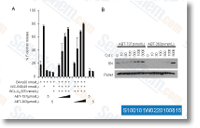Even though bioinformatic databases allow easy annota tion of candidates for their function, tissue expression, and potentially involved pathways, understanding of their function should be carried out inside the context from the cell variety and state with the cells. Due to the fact amniocytes repre sent a somewhat heterogeneous population that has not been fully characterized, speculating on each and every protein function inside the amniotic fluid cell proteome need to be approached with caution. For example, there may be an array of proteins which have been properly described in fully differentiated cells, despite the fact that the same proteins may very well be actively involved in improvement and or cellular differ entiation throughout fetal growth. As a result, details on their developmental functions from bioinformatic re positories could possibly be extremely limited.
Also, expression of pro teins in terminally differentiated cells may be pretty different from expression in stem cell like cells. More selleck over, gene dosage clearly is determined by the biological func tion on the item of your gene, including enzymes, structural proteins, transcription things, intracellular signaling molecules, cell surface markers, and receptors. There are some limitations of this study, which origin ate from the nature in the samples. By way of example, the heterogenous nature of amniotic fluid cells can intro duce false positives into our list of proteins that reflect DS pathogenesis, warranting a verification step. Also, the heterogeneity from the disease phenotypes along with the degree of severity make the analyses extra tough.
For ex ample, 50 to 60% of DS folks suffer from congeni tal cardiac kinase inhibitor Obatoclax defects, and some on the altered pathways for heart improvement could or couldn’t be captured in our candidate list, given that not all DS fetuses are affected. Even for the universal phenotypes, including cognitive de velopment, there is a wide range of severity, thus signature proteins for any from the phenotypes could po tentially be missing from our list, specifically at such an early stage of development. Conclusions In summary, this study identified more than four,900 proteins from primary amniocytes through proteomic discovery experiments, providing by far the most comprehensive proteome data for amniocytes, although quantifying more than 85% of the identified proteins by means of the SILAC strategy. Quantitative analysis showed that a minimum of 900 proteins have been poten tially dysregulated in amniocytes with T21.
The bioinfor matic molecular analyses revealed various pathways that appear to become most significantly affected by the pres ence of an extra copy of chromosome 21. Additional inves tigations of those pathways in fetal tissue may well enable elucidate molecular mechanisms that happen to be directly re sponsible for DS functions. We also created  targeted SRM assays for candidate verification and identified two proteins that could be involved within the molecular pathogenesis of DS throughout fetal improvement.
targeted SRM assays for candidate verification and identified two proteins that could be involved within the molecular pathogenesis of DS throughout fetal improvement.
Inhibitor Libraries
Biotechnology is the use of cells or organisms to develop products for humans.
